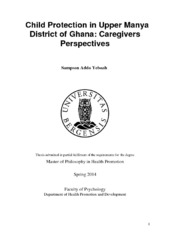Child Protection in Upper Manya District of Ghana: Caregivers Perspectives
Abstract
Abstract Introduction and Objectives: Ghana was one of the first countries to ratify the United Nations Convention on the Rights of the Child (UNCRC) and has since then nationalised it into a local law known as the Children's Law 1998 Act 560. However, almost two decades since the law came into effect, reports suggest that the situation of children has not improved. Ratification of international treaties such as UNCRC, and partnership between developed countries and Ghana a developing country maybe inevitable because much needed development aid for Ghana is tied to Human Right Treaties (HRT) and partnership agreements. Conditions attached to such partnership could go as far as agreements to allow the international community to influence and monitor implementation of Western developed policies in Ghana without much contextual consideration. These Western developed HRTs such as the UNCRC when implemented end up been less effective due to lack of local participation in these policies. Using the concept of partnership and participation this qualitative study explores the roles of the local community, national governments and international organisations on the issue of child protection. It tries to understand perspectives of caregivers on child protection through their experiences in a small rural community setting of Asesewa in the Upper Manya district of Ghana. Specifically it focuses on the perspectives of caregivers and how these perspectives are in consensus or otherwise with the Ghana Children's Law 1998 Act 560 and the UNCRC. Methods: Qualitative phenomenology was the strategy of inquiry for this study. Semi- structured interviews and focus group discussions were used to collect data from participants. Participants were of three main groups; group one consisted of Highly Educated Professionals (HEPs) these were professionals whose duties mainly include working to protect children. All HEPs had university level education and worked at the administrative level of child protection institutions. The second group consisted of Technically Trained Professionals (TTPs) these were professionals who have had tertiary education but not to the level of university education such as teacher training or nursing training. The third group consist of parents with children 12 years and below. All members were located in Asesewa. Interviews and focus group discussions were facilitated with an interview guide and audio recorded. They were conducted in English where the participants were educated, and Dangbe the local language where necessary. In total 33 purposefully selected participants contributed data. Discussions in the local language were translated into English before transcription. OpenCode computer software was used to manage data during analysis. v Findings and Discussion: Findings suggest that the understanding and practice of child protection are largely a contextual issue. Participating parents identified physical survival and some cultural practices as important to child protection; the practice of dipo a rites of passage for girls for instance was identified as a traditional custom that has protected girls from teen pregnancy although its effectiveness was waning. Extended family system was identified as a cushion for orphans and vulnerable...
